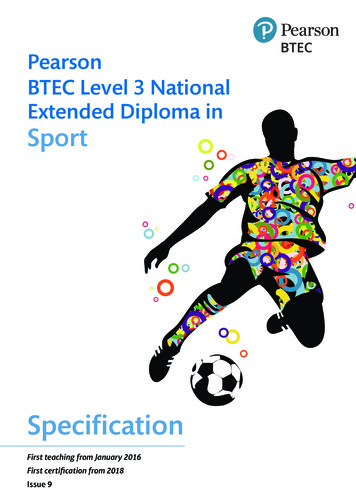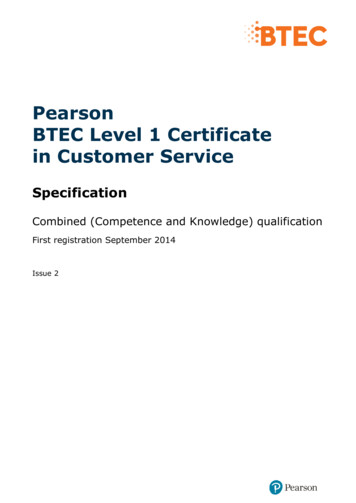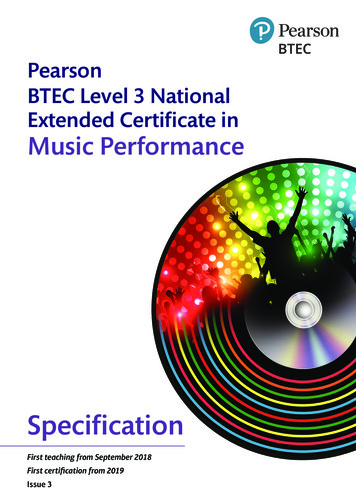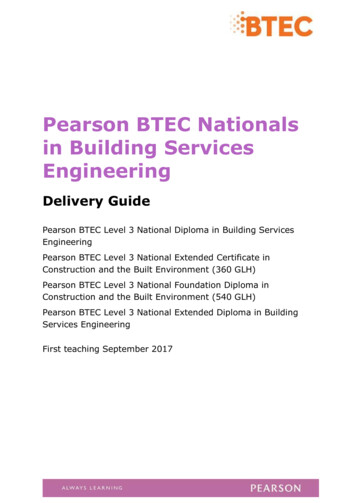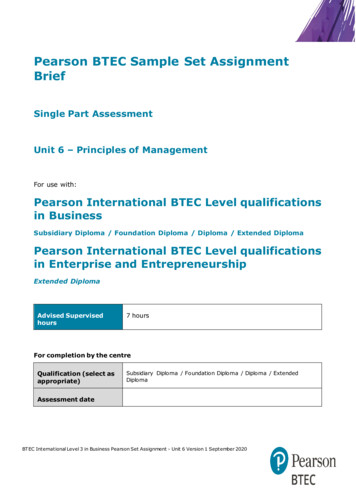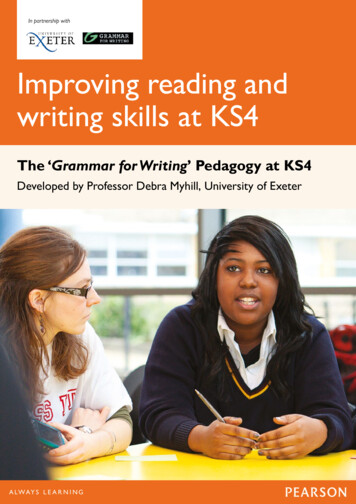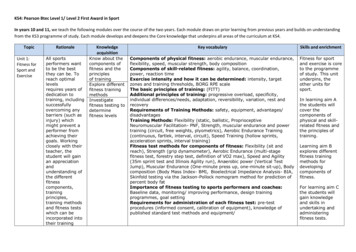
Transcription
KS4: Pearson Btec Level 1/ Level 2 First Award in SportIn years 10 and 11, we teach the following modules over the course of the two years. Each module draws on prior learning from previous years and builds on understandingfrom the KS3 programme of study. Each module develops and deepens the Core knowledge that underpins all areas of the curriculum at KS4.TopicUnit 1:Fitness forSport andExerciseRationaleKnowledgeacquisitionKey vocabularySkills and enrichmentAll sportsperformers wantto be the bestthey can be. Toreach optimallevelsrequires years ofdedication totraining, includingsuccessfullyovercoming anybarriers (such asinjury) whichmight prevent aperformer fromachieving theirgoals. Workingclosely with theirteacher, thestudent will gainan appreciationandunderstanding ofthe ning methodsand fitness testswhich can beincorporated intotheir trainingKnow about thecomponents offitness and theprinciplesof trainingExplore differentfitness trainingmethodsInvestigatefitness testing todeterminefitness levelsComponents of physical fitness: aerobic endurance, muscular endurance,flexibility, speed, muscular strength, body compositionComponents of skill-related fitness: agility, balance, coordination,power, reaction timeExercise intensity and how it can be determined: intensity, targetzones and training thresholds, BORG RPE scaleThe basic principles of training: (FITT)Additional principles of training: progressive overload, specificity,individual differences/needs, adaptation, reversibility, variation, rest andrecoveryRequirements of Training Methods: safety, equipment, advantages/disadvantagesTraining Methods: Flexibility (static, ballistic, ProprioceptiveNeuromuscular Facilitation- PNF, Strength, muscular endurance and powertraining (circuit, free weights, plyometrics), Aerobic Endurance Training(continuous, fartlek, interval, circuit), Speed Training (hollow sprints,acceleration sprints, interval training)Fitness test methods for components of fitness: Flexibility (sit andreach), Strength (grip dynamometer), Aerobic Endurance (multi-stagefitness test, forestry step test, definition of VO2 max), Speed and Agility(35m sprint test and Illinois Agility run), Anaerobic power (Vertical TestJump), Muscular Endurance (One-minute press up, one-minute sit-up), Bodycomposition (Body Mass Index- BMI, Bioelectrical Impedance Analysis- BIA,Skinfold testing via the Jackson-Pollock nomogram method for prediction ofpercent body fatImportance of fitness testing to sports performers and coaches:Baseline data, monitoring/ improving performance, design trainingprogrammes, goal settingRequirements for administration of each fitness test: pre-testprocedures (informed consent, calibration of equipment), knowledge ofpublished standard test methods and equipment/Fitness for sportand exercise is coreto the programmeof study. This unitunderpins, theother units forsport.In learning aim Athe students willcover thecomponents ofphysical and skillrelated fitness andthe principles oftraining.Learning aim Bexplores differentfitness trainingmethods fordevelopingcomponents offitness.For learning aim Cthe students willgain knowledgeand skills inundertaking andadministeringfitness tests.
KS4: Pearson Btec Level 1/ Level 2 First Award in SportIn years 10 and 11, we teach the following modules over the course of the two years. Each module draws on prior learning from previous years and builds on understandingfrom the KS3 programme of study. Each module develops and deepens the Core knowledge that underpins all areas of the curriculum at KS4.regime to furtherenhance andimprove theirsportsperformanceUnit 2:PracticalPerformancein SportParticipation insport continues togrow, as peoplebecome moreaware of thebenefits ofphysical activity.Engaging youngpeople throughsport is a keypolitical agenda,both becausecurrent nationalhealth statisticsshow that obesityin young childrenis rapidlyincreasing andalso because westrive forexcellence andUnderstand therules,regulations andscoring systemsfor ues andtactics inselected sportsBe able toreview sportsperformanceresources required, purpose of each fitness test, accurate measurement andrecording of test results, basic processing of test results for interpretation(using published datatables and appropriate units for comparison purposes), safely selectappropriate test(s) for given purposes, situations and/or participants,reliability, validity and practicality, advantages and disadvantages of fitnesstest methodsInterpretation of fitness test results: compare fitness test results tonormative published data, compare fitness test results to those of peers,draw conclusions from data results, analyse and evaluate test results,suggest and justify appropriate recommendations for improvements tofitness for a given purpose/situation/participant, justify appropriate fitnesstraining methods that could be used for a givenpurpose/situation/participant.Rules (or laws)Rules (or laws) as regulated by the national or international governing bodyfor the sport. For example, the Fédération Internationale de FootballAssociation (FIFA) laws of football, the International Rugby Board (IRB) lawsof rugby, the Badminton World Federation (BWF) rules of badminton, andthe International Orienteering Federation (IOF) rules of orienteeringRegulationsFor example, relating to players and participants, equipment, playingsurface, facilities, health and safety, time, officials (referee, umpire, judge,starter, timekeeper)Scoring systemsFor example, the method of scoring goals or points, method and/orrequirements of victory.Application of the rules/laws of sports in different situationsFor example, when a goal is scored when a player is in an offside position infootball, leg before wicket (lbw) in cricket, charging in lead up to scoring inbasketball, forward pass resulting in a try in rugby.SportsFor example, cricket, hockey, netball, rounders, volleyball, wheelchairbasketball, golf, trampolining, table tennis, archery, judo, cross-countryIn learning aim A,students willinvestigate therules andregulations of asport and apply theknowledge gainedthrough observingofficials in action.They might alsodecide to take partin nationalgoverning bodycoaching andleadership awardsto reinforce andextend theirknowledge andqualifications inthis area.
KS4: Pearson Btec Level 1/ Level 2 First Award in SportIn years 10 and 11, we teach the following modules over the course of the two years. Each module draws on prior learning from previous years and builds on understandingfrom the KS3 programme of study. Each module develops and deepens the Core knowledge that underpins all areas of the curriculum at KS4.success at majorsporting events.This unit focuseson developingand improvingstudents ownpractical sportsperformance.This is achievedthrough theiractiveparticipation inpractical activitiesand reflection ontheir ownperformance andthat of othersportsperformers.running, boccia, fencing, orienteering, skiing, canoeing, sailing, mountainbiking.Roles of officialsFor example, the roles of umpires, referees, referees’ assistants, judges,timekeeper, starters, table officials, third umpire, fourth official.Responsibilities of officialsFor example, appearance, equipment, fitness, qualifications, interpretationand application of rules, control of players, accountability to spectators,health and safety (equipment, facilities, players), fair play, use oftechnology, effective communication (voice, whistle, signals)Components of physical fitnessThe application of the components of fitness to a chosen sport. aerobic endurance: (the ability of the cardiorespiratory system to workefficiently, supplying nutrients and oxygen to working muscles duringsustained physical activity) muscular endurance: (the ability of the muscular system to workefficiently, where a muscle can continue contracting over a period of timeagainst a light to moderate fixed resistance load) flexibility: (having an adequate range of motion in all joints of the body;the ability to move a joint fluidly through its complete range of movement) speed: (distance divided by the time taken. Speed is measured in metresper second (m/s). The faster an athlete runs over a given distance, thegreater their speed) muscular strength: (the maximum force (in kg or N) that can be generatedby a muscle or muscle group) body composition: (the relative ratio of fat mass to fat-free mass (vitalorgans, muscle, bone) in the body) The application of the components of fitness to a chosen sport.o For example, football requires foot speed and muscular strength to allowthe player to reach the ball before their opponent and hold them off the ballto keep possession.o For example, long distance running requires good aerobic endurance tosupply oxygen and nutrients to working muscles during a race as well as alow body composition to ensure fat mass is low so that the distance can becovered more easily.For learning aim B,they will take partin a variety ofsports. These maybe sports in whichthey excel or havea particularinterest. They arerequired todemonstrate theskills, techniquesand tactics withineach of the sportsselected forassessment.For learning aim C,they will reviewtheir performancein the sports inwhich youparticipated. Thisreview will look atthe strengths andareas fordevelopment withintheir ownperformance. Theywill also beencouraged toconsider plans todevelop theirperformance withinthe selected sports.
KS4: Pearson Btec Level 1/ Level 2 First Award in SportIn years 10 and 11, we teach the following modules over the course of the two years. Each module draws on prior learning from previous years and builds on understandingfrom the KS3 programme of study. Each module develops and deepens the Core knowledge that underpins all areas of the curriculum at KS4.Technical demandsThese are the skills and techniques required. For example, continuous skills(such as running), serial skills (such as high jump), discrete skills (such as agolf swing), movement, use of equipment, communication, other demandsspecific to sport.Tactical demands Decision making and strategies to overcome an opponent, including usingpersonal strengths. Use of relevant tactics, e.g. defending and attacking, choice and use ofshots or strokes, variation, conditions, use of space, other demands specificto sport.Safe and appropriate participation The demonstration of skills, techniques and tactics within a controlledenvironment, for example no competition, drills, set plays. Adhere to ‘rules’, health and safety guidelines, and consider appropriaterisk management strategies in physical activity and sport.Relevant skills and techniquesThe skills and techniques relevant to the selected sport and practice.Relevant tacticsThe tactics relevant to the selected sport and practice/situationEffective use of skills and techniques, and the correct application ofeach componentFor example: rugby conversion, including head position, body position,placement of non-kicking foot, placement of kicking foot, connection with theball.Effective use of skills, techniques and tacticsThe use of skills and techniques within conditioned and competitivesituations, and effective decision making and selection of skills, techniquesand tactics when under pressure from opponents.Isolated practicesFor example, skills and techniques demonstrated independently without anypressure or external forces, completed successfully and without fault.Conditioned practicesFor example, small-sided games, a limited number of touches, a set numberof defenders or attackers.
KS4: Pearson Btec Level 1/ Level 2 First Award in SportIn years 10 and 11, we teach the following modules over the course of the two years. Each module draws on prior learning from previous years and builds on understandingfrom the KS3 programme of study. Each module develops and deepens the Core knowledge that underpins all areas of the curriculum at KS4.Unit 3:Applying thePrinciples ofPersonalTrainingThis unit is allabout thestudent, theindividualperformer,training toimprove andenhance personalfitness for a sportDesign apersonal fitnesstrainingprogrammeKnow about themusculoskeletalsystem andcardiorespiratorysystem and theCompetitive situations Full-sided games. Appropriate opposition. With match officials. Personal performance that contributes to relevant use of skills, techniquesand tactics in relation to:o communicationo individual roleo responding to team mates and/or opposition.Observation checklistFor example, to review performance in selected sports using video analysis: components of physical fitness technical demands of sport (skills and techniques) production of a checklist suitable for self-analysis of performance inselected sports tactical demands of sport.Review performance Strengths and areas for improvement: components of fitness, skills andtechniques, specific to the sport and non-specific, e.g. fitness. Self-analysis: completion of observation checklist, e.g. use of video. Strengths and areas for improvement: tactics, the effectiveness of decisionmaking. Activities to improve performance (short-term and long-term goals): e.g.training programmes, use of technology, attending courses, where to seekhelp and advice.Personal information to aid training programme design Personal goals: specific, measurable, achievable, realistic, time-related,evaluated, recognized/rewarded (SMARTER):o short-term goals (set over a short period of time, between one day andone month)o medium-term goals (should give progressive support towardsachievement of long-term goals)This unit issynoptic anddesigned so thatthe student thinksabout all of theirlearning fromacross thequalification, and
KS4: Pearson Btec Level 1/ Level 2 First Award in SportIn years 10 and 11, we teach the following modules over the course of the two years. Each module draws on prior learning from previous years and builds on understandingfrom the KS3 programme of study. Each module develops and deepens the Core knowledge that underpins all areas of the curriculum at KS4.of their choice.They must selectone component offitness and onemethod oftraining that ismost appropriate,beneficial andengaging toimprove theirfitness for theirchosenactivity/sport.This may meantraining with agroup of friendsin a local park, orusing a personalfitness trainingprogramme at alocal sports clubor leisure centre.Whatever thesetting, thedesign of thetrainingprogramme mustbe tailored tomeet theirpersonal traininggoals, aspirationsand needs.effects on thebody duringfitness trainingImplement aself-designedpersonal fitnesstrainingprogramme toachieve owngoals andobjectivesReview apersonal fitnesstrainingprogrammeo long-term goals (what they want to achieve in the long term, and the bestway of doing this). Aims (details of what they would like to achieve for the selectedactivity/sport). Objectives (how they intend to meet their aims using an appropriatecomponent of fitness and method of training). Lifestyle and physical activity history. § Medical history questionnaire. § Attitudes, the mind and personal motivation for training.Programme design Use personal information to aid training programme design. Selection of appropriate training method/activity for improving/maintainingthe selected component of fitness, e.g. flexibility, strength, muscularendurance and power, aerobic endurance, speed. Safe design: appropriate method/selection of an appropriate combinationof activities to meet personal training needs, goals, aims and objectives. § Application of the basic principles of training - Frequency, Intensity,Time and Type (FITT). § Application of the additional principles of training. Selection of appropriate activities for warm-up (light, continuous physicalactivity to prepare the body for exercise). Selection of appropriate activities for cool down (light, continuous physicalactivity to reduce heart rate, remove lactic acid and prevent blood pooling). § Creative design: consideration given to prevent/avoid barriers to trainingoccurring, ensuring exercise adherence is maintained and the programme isenjoyable, for example including interesting, different exercise activities tomaintain motivation and commitment, and to prevent boredom. § Intensity:o target zones and training thresholds (calculating and applying maximumheart rate (HR max) to training):o HR max 220 – age (years)o 60–85% HR max is the recommended training zone for cardiovascularhealth and fitnesso Borg Rating of Perceived Exertion (RPE) Scale (1970) (6–20) can be usedas a measure of exercise intensityuse it to respond tothe assessment.Learning aim Atakes the studentsthrough the stagesof designing apersonal fitnesstrainingprogramme, wherethey can select acomponent offitness and anappropriate methodof training toimprove ormaintain theirfitness levels safelyfor their chosenactivity/sport.For learning aim B,they will gainawareness of themusculoskeletalandcardiorespiratorybody systems andhow they respondduring theexercise.In learning aim C,they will implementtheir personal
KS4: Pearson Btec Level 1/ Level 2 First Award in SportIn years 10 and 11, we teach the following modules over the course of the two years. Each module draws on prior learning from previous years and builds on understandingfrom the KS3 programme of study. Each module develops and deepens the Core knowledge that underpins all areas of the curriculum at KS4.o the relationship between RPE and heart rate where RPE 10 HR (bpm).Musculoskeletal system Location of the major muscles: deltoid, biceps, triceps, pectoralis major,latissimus dorsi, external obliques, gluteus maximus, quadriceps,hamstrings, gastrocnemius and tibialis anterior. Location of the major bones: cranium, clavicle, scapula, ribs, sternum,humerus, radius, ulna, pelvis, femur, patella, tibia, fibula, Structure and function of the synovial joints at the hip, shoulder, knee,elbow. Short-term effects of fitness training on the musculoskeletal system:o the use of a warm-up and flexibility exercises to increase joint range ofmovemento § planning for progressive overload to encourage micro tears in musclefibresCardiorespiratory system Structures of the cardiovascular system: atria, ventricles, aorta, venacava, pulmonary artery, pulmonary vein. Structures of the respiratory system: lungs, bronchi, bronchioles, alveoli,diaphragm. Short-term effects of fitness training on the cardiorespiratory system:o increased heart rate and breathing rate during fitness training activities tosupply oxygen to working muscleso § increased build-up of lactic acid as a result of increased intensity in themain component.Safely implement a personal fitness training programme Using an appropriate training method (e.g. taking part in plannedsessions), performing to the best of your ability, gaining agreement fromcoach/trainer for any missed sessions, understanding the importance ofcommitment. Wearing correct training gear, safe and correct use of equipment,implementation of correct technique, awareness of wider safety issues, e.g.personal safety if training outdoors. § Taking full responsibility for completing and recording details for eachtraining session.Training diary for each session recordingfitness trainingprogramme,maintaining atraining diary.Finally, for learningaim D they willreview theirprogramme,looking atstrengths, areas forimprovement andsuggestingrecommendationsfor future trainingand performance.
KS4: Pearson Btec Level 1/ Level 2 First Award in SportIn years 10 and 11, we teach the following modules over the course of the two years. Each module draws on prior learning from previous years and builds on understandingfrom the KS3 programme of study. Each module develops and deepens the Core knowledge that underpins all areas of the curriculum at KS4. Date, time and location for training undertaken. Aims and objectives for each session. Session duration. Type of training undertaken – selected method/activity. Programme details (FITT). Log of personal performance and achievements. Resources required, e.g. equipment. The principles of progressive overload and details of how progressiveoverload has been achieved over the course of the programme. Details of programme intensity using % HR max and RPE.Measures for success Types of motivation (intrinsic and extrinsic) Benefits of motivation and self-confidence to successfully complete afitness training programme Motivation for training, including details in the diary of personal feelingsbefore, during and after each training session Details of how the programme has been adapted to ensure continuedcommitment to training, for example using a variation of activities/trainingmethods. Achievement against personal aims, goals and objectives, for example howperformance has been taken to a higher level.
KS4: Pearson Btec Level 1/ Level 2 First Award in SportIn years 10 and 11, we teach the following modules over the course of the two years. Each module draws on prior learning from previous years and builds on understandingfrom the KS3 programme of study. Each module develops and deepens the Core knowledge that underpins all areas of the curriculum at KS4.Unit 6:LeadingSportsActivitiesWhat makes thewinners of the topleagues sosuccessful? Whydid the winner oftheLondon Marathonselect the tacticsto run the race inthat specific way?Many peoplewould suggestthat it is down tothe individualperformer.However, othersKnow theattributesassociated withsuccessful sportsleadershipUndertake theplanning andleading of sportsactivitiesReview theplanning andleading of sportsactivitiesSports LeadersFor example, sports coaches, fitness instructors, school/college coaches,local club coaches, national club coaches, amateur coaches.Attributes Skills (communication, organisation of equipment, knowledge). Advanced skills (activity structure, target setting, use of language,evaluation). Qualities (appearance, enthusiasm, confidence). Additional qualities (leadership style, motivation, humour, personality).Responsibilities Core responsibilities (professional conduct, health and safety, equality). Wider responsibilities (insurance, child protection, legal obligations, ethicsand values, rules and regulations).Sports activitiesFor example, individual sports, team sports, fitness activities.PlanFor learning aim A,students will beintroduced to theattributes requiredto be a successfulsports leader,giving themknowledge of theskills, qualities andresponsibilitiesassociated withsuccess in sportsleadership.Learning aim Benables them to
KS4: Pearson Btec Level 1/ Level 2 First Award in SportIn years 10 and 11, we teach the following modules over the course of the two years. Each module draws on prior learning from previous years and builds on understandingfrom the KS3 programme of study. Each module develops and deepens the Core knowledge that underpins all areas of the curriculum at KS4.look beyond theperformer andcredit themanagers orcoaches.In sport it is oftenthe performerwho receives allthe admirationand acclaim fortheirachievements.However, behindmost successesthere is a sportsleader or coach,who mastermindsthe performanceof the highlytalented sportsperformer(s). It isoften theseleaders who makethe difference.This unitintroduces thestudent to sportsleadership,enabling them tostart on theladder ofleadership andcoaching, throughdeliveringcomponents of Participants, e.g. age, ability, gender, numbers, medical and specificneeds. Aims and objectives, e.g. target setting, expected outcomes. Resources, e.g. equipment, time, environment. Warm-up. Pulse raiser: activities that can be used to gradually increase the pulserate. Mobilise: activities to mobilise the main joints of the body such as knees,hips, shoulders, ankles and wrists.Lead Demonstration of attributes (skills, § advanced skills, attributes, §additional qualities). Completion of core responsibilities. Completion of wider responsibilities.Measures of success Coverage of planned components. Meeting set aims and objectives. Organised. Safe. Stretching (different types of stretches for the main muscles used in sportsactivity sessions – deltoids, triceps, erector spinae, obliques, quadriceps,hamstrings, gastrocnemius). Main component/components of activity, e.g. skill introduction,development, conditioned game, final activity. Incorporate safe activities to minimise injury. Cool down. Pulse lowering: activities that gradually decrease in intensity. Stretch: carry out maintenance and developmental stretches with the mainmuscles that were used in the activity session, including deltoids, biceps,triceps, erector spinae, abdominals, obliques, hip flexors, gluteus maximus,quadriceps, hamstrings, gastrocnemius. Health and safety considerations: adhere to health and safety guidelines,and consider appropriate risk management strategies. Risk assessment: environmental and injury prevention.Reviewconsider theplanning andleadershiprequirements fordelivering sportsactivities. They willbe given theopportunity todevelop their abilityand knowledge ofsports leadershipthrough developingknowledge of therequirements ofplanning and targetsetting for sportsperformers.For learning aim C,they will evaluatetheir owneffectiveness as asports leader withinthe session theyplanned anddelivered. They willneed to considertheir strengthswithin the processof sports leadershipand plans forfurther developingtheir ability as asports leader.
KS4: Pearson Btec Level 1/ Level 2 First Award in SportIn years 10 and 11, we teach the following modules over the course of the two years. Each module draws on prior learning from previous years and builds on understandingfrom the KS3 programme of study. Each module develops and deepens the Core knowledge that underpins all areas of the curriculum at KS4.sports sessionsand whole activitysessions. Theywill be introducedto the basics ofsports leadershipand then will berequired to plan,deliver andevaluate theirability to lead asports activitysession orcomponent of asession. Feedback for review, e.g. from participants, supervisor, observers, selfanalysis. Methods, e.g. questionnaires, comment cards, observation records, directverbal feedback. Strengths and areas for improvement (demonstration of attributes,completion of responsibilities, e.g. planning, content, organisation, healthand safety, achievements).Targets for development SMARTER targets (specific, measurable, achievable, realistic, time-related,exciting, recorded). Development plan:o aims and objectiveso goalso SMARTER targetso activities and opportunities, e.g. training, courses, qualificationso possible barriers.
fitness test, forestry step test, definition of VO2 max), Speed and Agility . facilities, health and safety, time, officials (referee, umpire, judge, starter, timekeeper) Scoring systems For example, the method of scoring goals or points, method and/or . running, boccia, fencing, orienteering, skiing, canoeing, sailing, mountain biking .
